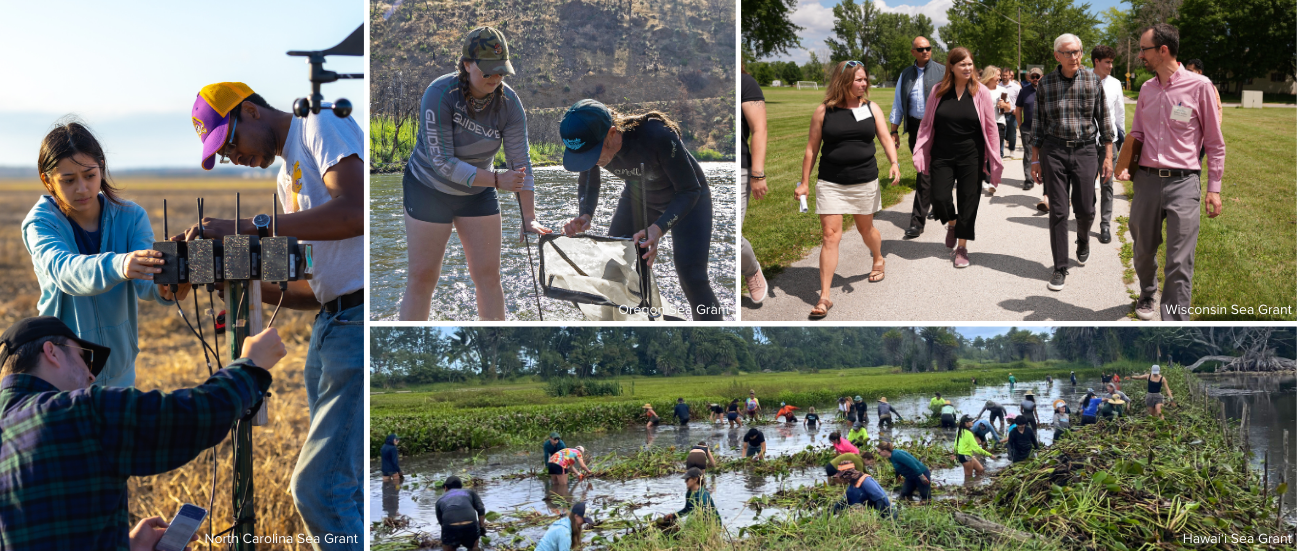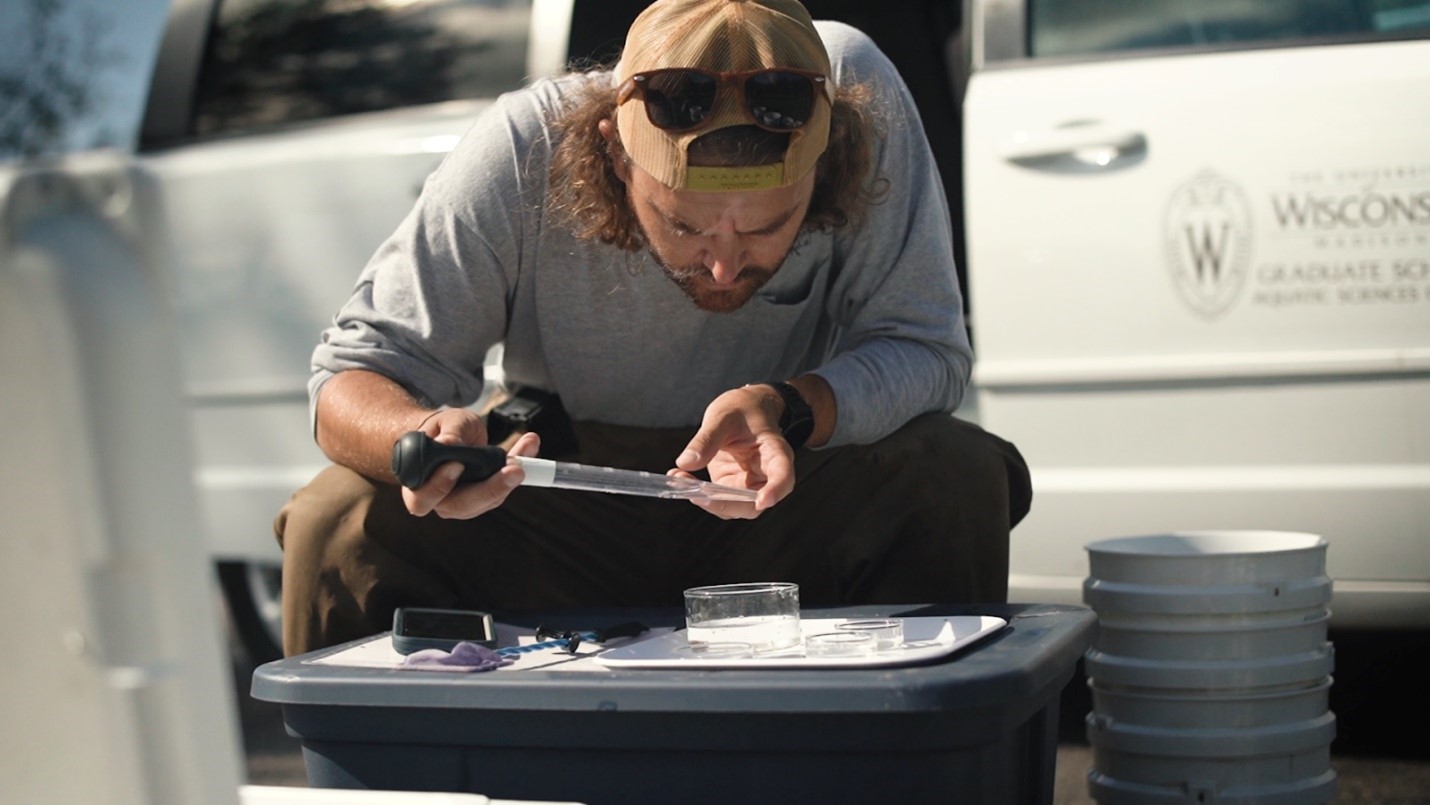At Milwaukee’s Vincent High School there’s something pretty fishy going on. And green. And sweet like honey. It’s the stirrings of a full-blown, and the state’s largest, school-based urban agricultural program with a robust aquaculture angle to boot. Wisconsin Sea Grant was there at its beginnings in 2010.
Aquaculture Specialist Fred Binkowski and co-worker Henry Herbert, an aquaponics expert, have spent many hours in the school, advising on the engineering of an aquaponics system—one that provides ideal water chemistry—and fish biology. You need both to successfully rear yellow perch. The small fin fish are the centerpiece of Binkowski’s longtime aquaculture work, including aquaponics, which is a fish/salad greens production system. The fish fertilize the plants and the plants clean the water for the fish in a closed-loop system.
“The mission of the program is to get students to understand sustainability and how it works,” said Richard DePalma, a science teacher. “The program also shows students how to use sustainability post-secondarily, leading to education and jobs.”
DePalma, said Binkowski, quickly synthesized and put into use the promise of aquaponics’s sustainability.
“Rich is very independent. He got it right away,” Binkowski said. “Just as importantly, Rich is really good with the students. He also knows the fish.”
Beyond that, DePalma drew on the knowledge and experience of the 20-plus-year aquaculture program at Freedom High School in northeastern Wisconsin. Sea Grant has been integral to the startup and success of that program. In fact, Binkowski is slated to work with that school to revamp its model curriculum within the coming months—building on an already good thing.
At Freedom, students also spawn and hatch their own yellow perch. It’s nature taking its course, but with a bit of a boost from Binkowski’s innovation. He has spent years perfecting a process to get the tasty whitefish to spawn out of season by manipulating light and water temperature. In 2010, the U.S. Patent Office awarded him a patent for the process.
Freedom’s Kevin Champeau founded the program and added the spawning curriculum. Champeau has noted it pays off for students, saying, “It’s a skill that not a lot of kids know. So if I can give my kids that skill, they can put that on their resume as something they know that a lot of other people don’t know.”
Vincent High School may eventually incorporate out-of-season spawning into its program, “taking the fish from gene to plate,” as DePalma said. First things first, however. DePalma currently teaches a greenhouse course as part of the school’s urban agricultural initiative, but as yet there is no dedicated course on aquaculture.
Rather, elements of aquaculture are woven into other classes.
A second urban agricultural team member, Science Teacher Mark Hladilek, said “An aquaculture course has a lot of possibilities,” in that it could encompass tenets of biology, engineering and chemistry. It also offers pathways to good jobs in the food industry, he said.
When an aquaculture course comes to fruition, Hladilek said, it would be due to Binkowski and Herbert’s inspirational assistance. In fact, Hladilek broadens out his credit for the school’s current aquaponics accomplishments. “It wouldn’t be working without their input.” He said they have supplied both fish and the knowledge to care for the fish.
For Shamika Suggs, the care is important. Plus, she appreciates the ag program’s window into something more: “I want to know where my food comes from. I want to go to the grocery store and know what’s in that can, what’s in that package.”
Suggs, 16, is enrolled in DePalma’s greenhouse course. She tends the fish and plants, and has learned the skills of plant cloning.
“It all sounded interesting. I wanted to get into the plants and the fish,” Suggs said as she explained that her mom and her friends are now the beneficiaries of her pass-along food-sourcing knowledge.
Suggs is one of about 300 students enrolled in an agriculture course. The school has a total student body of about 1,100 and it sits on 93 acres. It’s perfectly primed for its agricultural instruction. In fact, the school was constructed in the 1970s with an agricultural focus in mind. It’s a focus that had fallen away in recent years only to be revived through the efforts of Principal Matthew Boswell, and others.
Boswell said, “The program is a way to connect to real-world jobs” as classes on biotechnology, veterinary science, biofuels, landscape design, urban gardening and aquaponics are being or will be offered.
Other students have gotten involved in the urban ag initiative. Binkowski noted that technical-education students built the wooden framing for the aquaponics system. They are also constructing a second hoop house to go with an existing one. The urban ag students will plant, tend and harvest crops that will eventually appear in the school’s cafeteria. Near the hoop house, bees that now trace lazy loops and supply the school with honey can’t yet know about their soon-to-be neighbors, the chickens. The chickens will provide eggs, and eventually meat, to the Vincent community.
Vincent’s urban ag students are being supported by their more traditional rural brethren. “It’s cool to see agriculture in a more urban setting,” said current Wisconsin President of Future Farmers of America Kayla Hack at a recent open house at Vincent. “The Chicago High School for Agricultural Sciences is popular and providing students with opportunities. It’s really exciting to have something like that in Wisconsin.”
She, too, is excited about the inclusion of aquaculture in the urban agriculture program, saying she is part of a national committee on the subject. Hack hopes to bring to her peers an awareness of aquaculture’s foothold and milestones in the Midwest, and how those stack up against the perhaps more well-known practices on the saltwater coasts.





